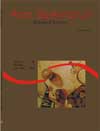<b>Ecological aspects of <em>Diplectanum piscinarius</em> (Platyhelminthes, Monogenea) parasite of gills of Plagioscion squamosissimus (Osteichthyes, Sciaenidae) in the Upper Paraná River floodplain, Brazil</b> - DOI: 10.4025/actascibiolsci.v27i3.1279
Abstract
Thirty-nine specimens of Plagioscion squamosissimus Heckel, 1840 were collected through nets of different mesh sizes in the Upper Paraná River floodplain. The occurrence of Diplectanum piscinarius Kritsky and Thatcher, 1984 was registered and it presented mean abundance of 31, mean intensity of 31.8 and prevalence of 97%. This paper also brings an ecological analysis of some aspects of the host-parasite relationship between D. piscinarius and P. squamosissimus. There were not significant differences between the prevalence and intensity of parasitism of males and females. There were not correlations between abundance and prevalence and the standard length of the hosts; and between relative condition factor (Kn) and abundance. From the results it is possible to assume that there are few physiological and behavioral differences between male and female hosts. Physiological changes probably do not occur during the development of the hosts and parasites do not seem to be very pathogenicDownloads
Download data is not yet available.
Published
2008-03-26
How to Cite
Tavernari, F. de C., Bellay, S., Takemoto, R. M., Guidelli, G. M., Perez Lizama, M. de L. A., & Pavanelli, G. C. (2008). <b>Ecological aspects of <em>Diplectanum piscinarius</em> (Platyhelminthes, Monogenea) parasite of gills of Plagioscion squamosissimus (Osteichthyes, Sciaenidae) in the Upper Paraná River floodplain, Brazil</b> - DOI: 10.4025/actascibiolsci.v27i3.1279. Acta Scientiarum. Biological Sciences, 27(3), 225-229. https://doi.org/10.4025/actascibiolsci.v27i3.1279
Issue
Section
Ecology and Limnology
DECLARATION OF ORIGINALITY AND COPYRIGHTS
I Declare that current article is original and has not been submitted for publication, in part or in whole, to any other national or international journal.
The copyrights belong exclusively to the authors. Published content is licensed under Creative Commons Attribution 4.0 (CC BY 4.0) guidelines, which allows sharing (copy and distribution of the material in any medium or format) and adaptation (remix, transform, and build upon the material) for any purpose, even commercially, under the terms of attribution.
Read this link for further information on how to use CC BY 4.0 properly.
0.6
2019CiteScore
31st percentile
Powered by 

0.6
2019CiteScore
31st percentile
Powered by 











1.png)




3.png)













